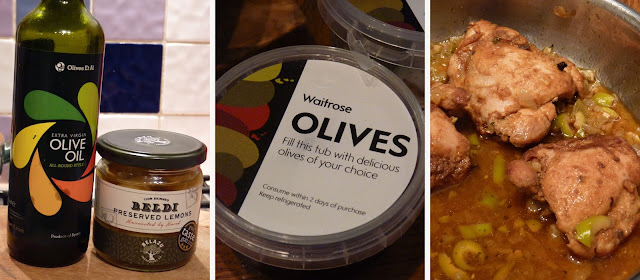Повторение пройденного!

Вам нужно скомпоновать так называемую Марокканскую смесь:
2 чайные ложки паприки
1 чайная ложка молотого тмина
1 чайная ложка молотого имбиря
1 чайная ложка куркумы
Корица 1/2 ч.л
1/4 чайной ложки свежемолотого перца
Положить 6-8 кусочков курицы (я люблю без шкуры) в полиэтиленовый пищевой пакет и натереть в нем кусочки этой смесью - это легко и руки чистые!
Оставить мариноваться от часа до…на ночь в холодильнике.
Затем как следует поджарить на хорошо раскаленной сковороде с антипригарным покрытием в нескольких ложках оливкового масла до золотистого цвета (я добавляю чуть сливочного)!
Переложить кусочки курицы в “Козероль”/Жаровню/Dutch oven.
А в той сковороде, в которой жарили кусочки, поджарьте в течение примерно 10 минут:
1 нарезанную луковичку +
3 зубчика чеснока (измельченных) +
1-2 консервированных лимона (у нас продают в баночках)
100г оливок (любого цвета)
Залейте по готовности эту смесь куриным бульоном - 200 мл, дайте прокипеть.
Затем всю эту душистую смесь - на курочку в жаровне.
Солить мне не пришлось - оливки были солеными.
Закройте крышкой жаровню, дайте закипеть и поставвьте в предварительно разогретую до 180С духовку на 45 минут мах!
Посыпать свежей петрушкой и кориандром и на стол …с Кус-кус (сouscous)!
Вкуснота!
Вам нужно скомпоновать так называемую Марокканскую смесь:
2 чайные ложки паприки
1 чайная ложка молотого тмина
1 чайная ложка молотого имбиря
1 чайная ложка куркумы
Корица 1/2 ч.л
1/4 чайной ложки свежемолотого перца
Положить 6-8 кусочков курицы (я люблю без шкуры) в полиэтиленовый пищевой пакет и натереть в нем кусочки этой смесью - это легко и руки чистые!
Оставить мариноваться от часа до…на ночь в холодильнике.
Затем как следует поджарить на хорошо раскаленной сковороде с антипригарным покрытием в нескольких ложках оливкового масла до золотистого цвета (я добавляю чуть сливочного)!
Переложить кусочки курицы в “Козероль”/Жаровню/Dutch oven.
А в той сковороде, в которой жарили кусочки, поджарьте в течение примерно 10 минут:
1 нарезанную луковичку +
3 зубчика чеснока (измельченных) +
1-2 консервированных лимона (у нас продают в баночках)
100г оливок (любого цвета)
Залейте по готовности эту смесь куриным бульоном - 200 мл, дайте прокипеть.
Затем всю эту душистую смесь - на курочку в жаровне.
Солить мне не пришлось - оливки были солеными.
Закройте крышкой жаровню, дайте закипеть и поставвьте в предварительно разогретую до 180С духовку на 45 минут мах!
Посыпать свежей петрушкой и кориандром и на стол …с Кус-кус (сouscous)!
Вкуснота!






